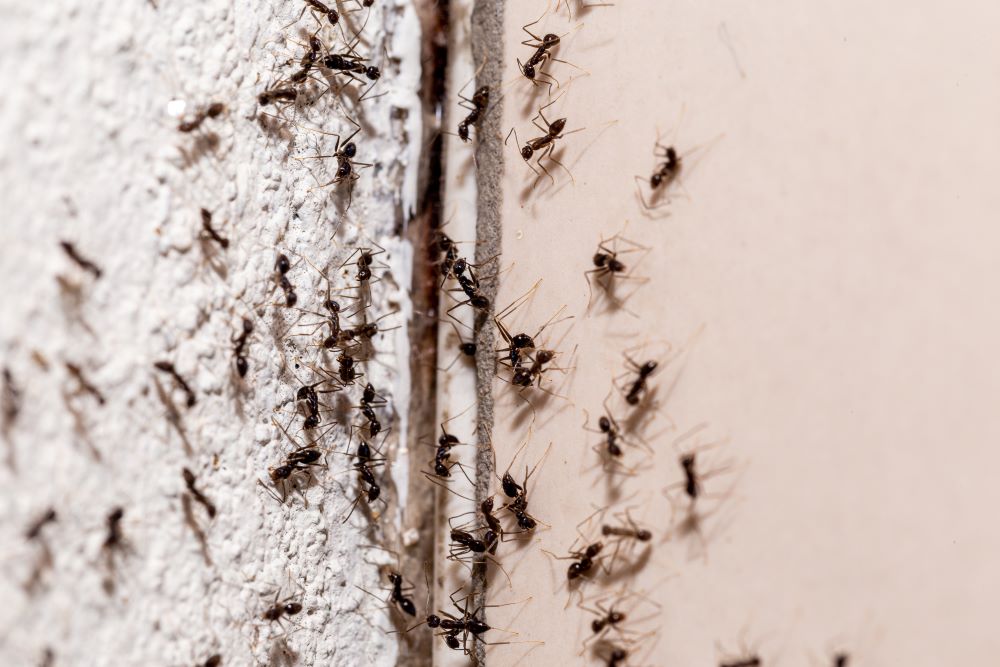Table of Contents
Dealing with ants can be quite a challenge, but when they decide to take up residence within your house walls, the problem escalates to a whole new level. This article will guide you through understanding why ants prefer wall dwellings, how to identify them, and how to eliminate the colonies effectively. We will also delve into some frequently asked questions about these uninvited guests in our homes. By the end of this guide, you’ll be equipped with the knowledge to tackle any ‘ants in walls’ situation.
Why Do Ants Favor Wall Dwellings?
Ants are tiny creatures that seek shelter in a variety of places depending on their species, and one such place is within the walls of your home. Walls provide ants with several benefits including an easy source of food and water, protection from predators, and a warm, moist environment.
Ants are attracted to the warm, damp conditions that are common within wall structures. Wall voids, cracks, and crevices provide the ideal environment for a thriving ant colony.
Moreover, walls often have small openings, like gaps around pipes or wiring, that make it easy for ants to enter and exit the structure. It’s like a private ant highway, allowing them to forage for food and return to the safety of their nest without being noticed.
Identifying the Presence of Ants In Your Walls
Identifying an ant infestation within your walls can be a bit tricky. Here are some common signs to look out for:
1. Sightings of Ants
This is the most obvious sign. If you see ants crawling out from your walls, there’s a high chance that a colony has made a home behind those walls.
2. Ant Trails
Ants are known to follow the same path when they forage for food. If you notice a procession of ants marching in a line along your wall, it’s a clear sign of an infestation.
3. Sounds within the Walls
Some species, like carpenter ants, are known to make a rustling sound that can be heard if you listen closely. This is the sound of them chewing through the wood in your walls.
4. Small Holes in the Wall
Carpenter ants, in particular, can leave small holes in your wall as they burrow into the wood to create their nests.
Common Ant Species That Live In Walls
There are several species of ants that are known to dwell within walls. Here are some of the most common ones:
1. Carpenter Ants
Carpenter ants are infamous for their wood-destroying behavior. They excavate their nests in both sound and decayed wood. They can cause severe damage to wooden structures, especially if they’ve been present for a long time.
2. Sugar Ants
Sugar ants, also known as pavement ants, are attracted to sweet foods. They can infest wall voids and other spaces in your home.
3. Pharaoh Ants
Pharaoh ants are small, yellowish-brown ants that like to nest in moist areas. They can infest interior wall voids and other similar spaces.
4. Acrobat Ants
Acrobat ants are known to nest in door and window frames, particularly those damaged by other insects or moisture. They can also invade wall voids.
5. Argentine Ants
Argentine ants are attracted to damp environments. They can establish their nests in wall voids and other similar spaces.
How to Get Rid of Ants In Walls
Once you’ve confirmed that you have ants in your walls, you need to act swiftly to eliminate them. Here are some step-by-step instructions:
1. Identify the Ant Species
Understanding the species of ant you’re dealing with is essential. Each species has different habits and preferences, which will influence the best method for elimination.
2. Locate the Nest
Find the ant nest if possible. This could be challenging, especially if the nest is deep within your walls. But, if you can locate and destroy the nest, you’ll have a much better chance of eliminating the infestation.
3. Use Ant Baits and Traps
Ant baits and traps are a great way to deal with an ant infestation. The ants are attracted to the bait, carry it back to their nest, and share it with the rest of the colony, leading to the elimination of the whole colony.
4. Use Pesticides
If the infestation is severe, you may need to use pesticides. The type of pesticide you choose will depend on the species of ant you’re dealing with.
5. Seal Cracks and Holes
After you’ve eliminated the ants, it’s crucial to seal any cracks or holes in your walls to prevent future infestations.
6. Consider Professional Pest Control Services
If you’re unable to handle the infestation on your own, you might need to call a professional pest control service like RECON Pest Services. They have the expertise and tools to deal with ant infestations efficiently.
Frequently Asked Questions About Ants In Walls
1. Can Ants Damage Walls?
Absolutely! Certain species like carpenter ants can cause serious damage to your walls as they burrow through the wood to create their nests.
2. Why Are Ants Coming Out of My Walls?
Ants might be coming out of your walls because they’ve established a nest within. They could be foraging for food or looking to expand their colony.
3. How Do I Prevent Future Ant Infestations?
To prevent future infestations, it’s important to seal any cracks or holes in your walls. Keeping your home clean and storing food in airtight containers can also help deter ants.
Conclusion
Having ants in your walls can be a major headache, but it’s a problem that can be solved with the right knowledge and approach. Whether you opt for DIY methods or choose to call in the professionals, it’s important to address the issue as soon as possible to prevent further damage. Remember, RECON Pest Services is here to help you keep your home ant-free. Contact us today for a free pest control quote!





